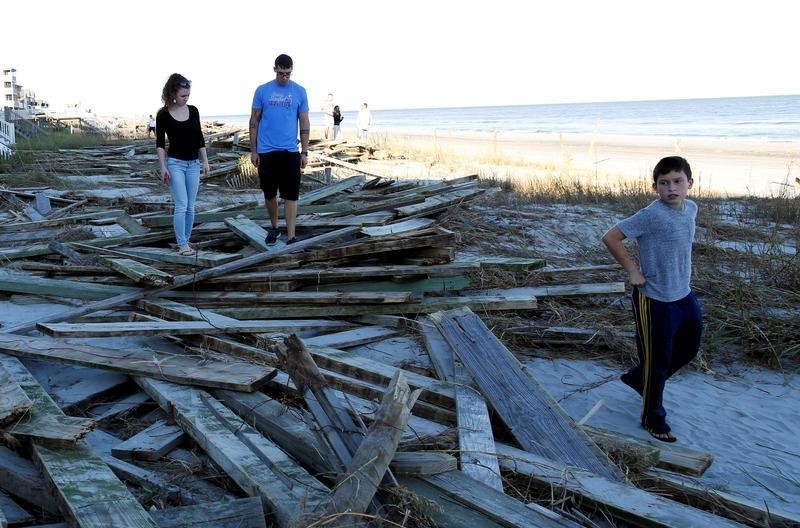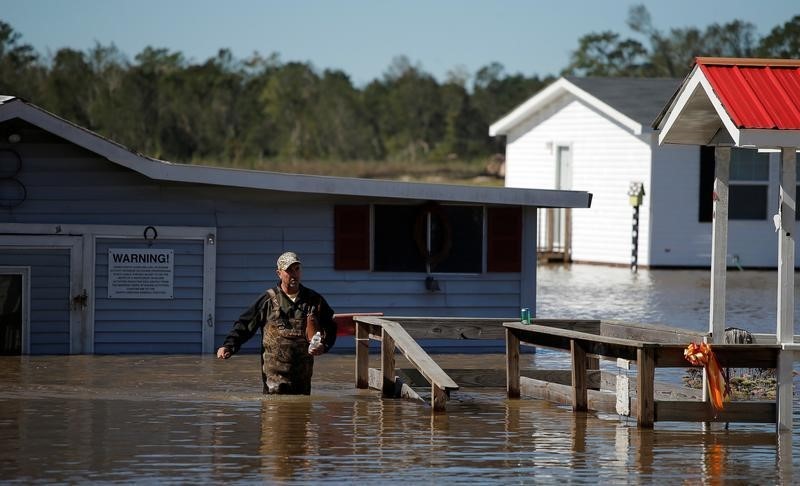
By Judy Royal
CAROLINA BEACH, N.C. (Reuters) – Floodwaters left hundreds of people stranded in their homes and on rooftops in North Carolina early on Monday, and officials warned life-threatening flooding from swollen rivers would continue for days after Hurricane Matthew ravaged the southeastern United States.
Matthew, the most powerful Atlantic storm since 2007, was downgraded to a post-tropical cyclone on Sunday after its rampage through the Caribbean killed 1,000 people in Haiti.
In the United States, the death toll rose to at least 21 people with nearly half of the fatalities reported in North Carolina.
After receiving more than a foot (30 cm) of rain from Matthew during the weekend, skies were clear over North Carolina on Monday but the storm’s after-effects were creating major problems by overwhelming rivers and breaching levees.
“Hurricane Matthew is off the map, well into the ocean, but it still is right here in North Carolina,” Governor Pat McCrory said at a new conference on Monday. “This is an extremely dangerous situation.”
Ten people have died in the state, including a person killed after a car was driven into floodwaters and swept away in Johnston County on Sunday, McCrory said. With rivers rising, the governor said he expected the number of dead to increase.
Some 1,500 residents were stuck in their homes and on rooftops in Lumberton after an unexpected river levee breach Monday morning, McCrory said. Air and water rescues were underway in the city, where hundreds of people evacuated their homes overnight hours before the breach and floodwaters continued to rise quickly, he said.
McCrory said several other swollen rivers in the central and eastern parts of the state were expected to hit record levels and would crest throughout the week. Residents in several cities were urged to evacuate.
The National Weather Service said “life-threatening flooding” would continue on Monday over eastern portions of the state.
BREACHED DAMS
Many coastal and inland communities remained under water, either from coastal storm surge or overrun rivers and creeks.
All 2,000 residents of Princeville were told on Sunday to evacuate due to flash flood risks. The town lies on the Tar River about 25 miles (40 km) north of Greenville.
Several dams have breached in the area around Cumberland County, south of Raleigh, Michael Martin, fire marshal for the city of Fayetteville, said by phone.
Rescue teams still are on alert and there have been 1,400 people rescued. More than 600 National Guard troops were aiding in rescue and recovery efforts in the state.
In neighboring South Carolina, a vehicle trying to cross a flooded roadway in Florence County was swept away by floodwaters, killing one person, Governor Nikki Haley said on Sunday.
Jake Williams of Florence said on early Monday that his power had been out since Saturday morning.
“Trees are down in every neighborhood on almost every road,” he said. “I am no weather man but would guess that the gusts of wind were near 100 mph (160 km), and with soggy ground a lot trees couldn’t stand up to it.”
In Virginia Beach, the city said it had received more than 13 inches (33 cm) of rain and 55,000 people remained without power on Sunday night. The city said some 200 vehicles were abandoned and many roads remained impassable.
Norfolk, which declared a state of emergency, said efforts were underway to clear streets of debris and abandoned vehicles with city offices, libraries and recreational centers set to re-open Monday.
While power was being restored in some areas, 1.2 million people were without power in Florida, Georgia, North and South Carolina and Virginia, down from Sunday’s peak of 2.2 million.
Before the National Hurricane Center discontinued tropical storm warnings for Matthew, it was about 200 miles (320 km) off the coast of Cape Hatteras, North Carolina, and heading away from land as of late on Sunday.
The National Hurricane Center said on Monday morning that tropical storm Nicole was expected to strengthen into Tuesday. The storm was about 500 miles (800 km) south of Bermuda and moving northward toward the island.
The Atlantic hurricane season runs until Nov. 30.
(Writing by Timothy Mclaughlin and Laila Kearney; Editing by Colleen Jenkins and Bill Trott)











